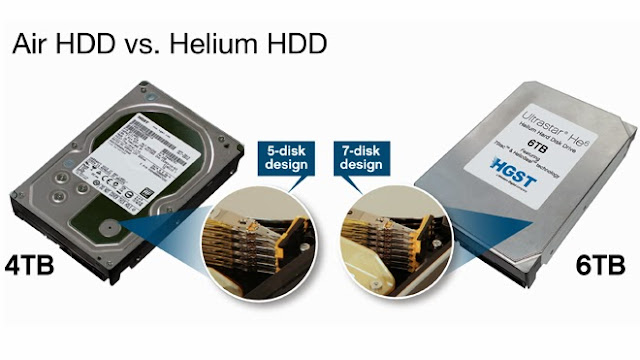Helium-filled hard drive

World's first 6TB Helium-filled Hard drive prepared
A well known Western Digital company which purchased HGST (Hitachi Global Storage Technologies) in 2012 has revealed a World's first Helium-filled hard disk with 6 Terabyte capacity. The new hermetically sealed, helium hard drive” uses 23% less power and is 38% lighter than the 4TB drives. Without changing the height, the new 6TB Ultrastar He6 enterprise-class hard drive crams seven disk platters into what was a five disk-platter, 4TB Ultrastar drive. As far as common hard drive is concerned , it consists of only air and oxygen. Air and oxygen not only affects the hard disk material but also weighs more and intervenes in work. By replacing the air and oxygen in a hard drive with helium (a gas that is seven times less dense than air) the disks inside create less turbulence when they spin, meaning more discs can be packed into less space and use less power.

In numbers the new six terabyte hard drives are 23 per cent more power efficient and offer 50 per cent more capacity than regular drives. It's an innovation that tackles a purely mechanical problem (the limit of how fast disks can spin when packed closer together) to create a high-tech improvement. Helium gas is a noble gas that's why it doesn't react with any other material at all. Now you don't need to worry about rust or any other chemical reaction which can damage or harm the hard disk. An other important details that you can also increase the strength of plates in it. According to experts Helium-filled hard disk can spin 20 thousand times in a second. Such a nice a efficiency will embark the ability to read and write the data. Since Helium gas will become less turbulence that's why motor inside consumes less electricity.

Helium-filled hard drive idea isn't new as far as my knowledge is concerned. A patent was prepared in 1980 of Helium-filled hard drive, but it was not possible to proceed it at trading level at that time. The preparation of such hard drive has to go through many processes and during process "air-tight" of hard disk isn't easy task as well e filled with Helium gas for many years wan't easy. In numbers the new six terabyte hard drives are 23 per cent more power efficient and offer 50 per cent more capacity than regular drives. It's an innovation that tackles a purely mechanical problem (the limit of how fast disks can spin when packed closer together) to create a high-tech improvement. Storage companies have been experimenting with helium for decades but creating a manufacturing process that produces long-time airtight hard drives has proved elusive until now.
In this fast pace of human's digital life Western Digital company has succeeded to overcome all those problems which were not possible at that time and prepared "Ultrastar He6" Hard drive. In order to make it more remarkable Western Digital embark plates from 5-7, however it's speed is still 7200 RPM. Normal Western Digital Ultrastar is quite expensive that's why we can expect that the new "Ultrastar He6" will be very expensive. Although this sort of technology might be slightly beyond the ken of the average consumer at least for now) the ability for large data centers to fit more storage into less space using less power has all sorts of escalating benefits.





.jpg)
6 comments:
Curious as to what the guarantee amounts to? Replacement cost of the drive is nothing compared to the loss of the data if sufficient backup isn't available.
Never knew that. Amazing. Does anything leak in? If not, wouldn't this end up creating a vacuum? Or wouldn't the vacuum it pushed the system towards work towards keeping the helium in? Does the thickness of the metal work to prevent this or doesn't it matter because the heium just sort of gets "lost" in the metal?
Hurry up fusion power... we need the helium.
From someone who has little to no appreciation for the finer points here, why not evacuate the hd case? Once upon a time there existed vacuum tubes...keeping relatively huge nitrogen and oxygen molecules out ought to be far easier than keeping tiny helium ones in.
Air is a lubricant in this case. Much harder to operate without it.
Really? How does that work -- moving gas holding the heads at the right height? It would seem the forces from the moving gas would vary a lot from low near the center of the platter to high near its edge, just as the angular velocity of any point on the platter varies from zero at the center to some value at the rim. I'm sure I'm missing something here; and what other way of keeping the heads at the right height is there?
Maybe "evacuate" was not quite right, but instead closer to "partially evacuate".
Post a Comment